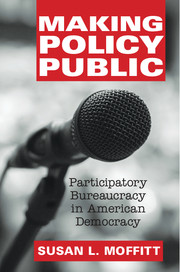Book contents
- Frontmatter
- Dedication
- Contents
- List of Figures
- List of Tables
- Preface
- Abbreviations
- 1 Portals of Democracy in American Bureaucracy
- 2 Participatory Bureaucracy in Practice
- 3 The Development of Public Committees
- 4 Making Educational Performance Public
- 5 Private Knowledge for Public Problems
- 6 Setting the Public Agenda
- 7 Deliberate Participation
- 8 The Impact of Public Advice
- 9 Participatory Bureaucracy in American Democracy
- Appendix
- Bibliography
- Index
- References
6 - Setting the Public Agenda
Published online by Cambridge University Press: 05 October 2014
- Frontmatter
- Dedication
- Contents
- List of Figures
- List of Tables
- Preface
- Abbreviations
- 1 Portals of Democracy in American Bureaucracy
- 2 Participatory Bureaucracy in Practice
- 3 The Development of Public Committees
- 4 Making Educational Performance Public
- 5 Private Knowledge for Public Problems
- 6 Setting the Public Agenda
- 7 Deliberate Participation
- 8 The Impact of Public Advice
- 9 Participatory Bureaucracy in American Democracy
- Appendix
- Bibliography
- Index
- References
Summary
FDA has come to realize that safe and effective use of drugs does not mean safe and effective theoretically as in the label, but safe and effective in the real world. FDA is concerned about how drugs are actually used; how physicians use the drugs; how the public uses them; if the medical community understands risks and benefits of the drug, and how to improve this understanding and actual safe and appropriate use of the drugs. This problem is a complex problem that is not solved by government, not solved by FDA alone, and not solved for just one drug
Former FDA Office Director, Florence Houn, before the Gastrointestinal Drugs Advisory CommitteeThe development of public committees for national educational assessments and pharmaceutical regulation suggests potential portals for public engagement in agency policymaking. When does that engagement reflect the criteria of participatory bureaucracy consistent with bureaucratic reputation for cultivating unique expertise and diverse support? When does engagement reflect participatory oversight or group dominance? Looking closely at committee agendas allows us to assess task-specific conditions for public advice along the continuum of task uncertainty and interdependent implementations.
Agenda setting embodies a source of political power by determining which issues are open for participation and which are not. Agendas affect who is included in the discussion and who is excluded, and they can confer privilege through the sequence of topics under consideration. Examining agendas on public committees offers opportunities to discern potential sources of privilege and power in agency policymaking. When they succeed at liquefying knowledge, public committees’ agendas may contribute to a broader public agenda as well.
Information
- Type
- Chapter
- Information
- Making Policy PublicParticipatory Bureaucracy in American Democracy, pp. 128 - 169Publisher: Cambridge University PressPrint publication year: 2014
